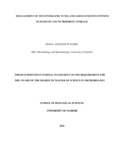| dc.description.abstract | Maize is a staple food crop in Kenya with about 90% of the rural households depending on it. However, the grain is vulnerable to degradation by mycotoxin producing fungi in the field and during storage. Mycotoxins produced by these fungi cause significant economic losses and deleterious health effects to humans and animals. Strategies such as storage of maize in hermetic bags have been developed to reduce post-harvest grain losses due to pest attack, fungal growth and mycotoxin contamination. The objective of this study was to determine the effect of hermetic storage on the population of fungal species and levels of aflatoxin and fumonisin in maize. A survey was carried out in October, 2015 to obtain information on maize production practices in Kilala and Mukuyuni Locations of Kaiti District, Makueni County, Kenya. Soil samples were collected at planting and analysed for the population and incidence of mycotoxin producing fungi. Maize grains were sampled at harvest and three months after storage in polypropylene and hermetic bags. Mycotoxin producing fungi in soil and ground maize were isolated and identified based on cultural and morphological characteristics and DNA analysis using ITS1F and ITS4R primers. Aflatoxin and fumonisin in maize grains sampled at harvest and after three months of storage were determined using VICAM method. Over 50% of the farmers in Kaiti District were smallholder who practiced mixed cropping, used simple land preparation methods, applied soil amendments and did not practice crop rotation. Fifty seven percent of farmers stored their maize in modern stores while 43.4% stored maize inside family living houses. Maize was mostly stored in polypropylene bags and the most common storage problem reported by farmers was infestation by insect pests mainly weevils. Eighty seven percent of the farmers had prior knowledge of mycotoxins and considered it a major challenge in maize production. Aspergillus spp., Fusarium spp. and Penicillium spp. were commonly isolated from | en_US |



